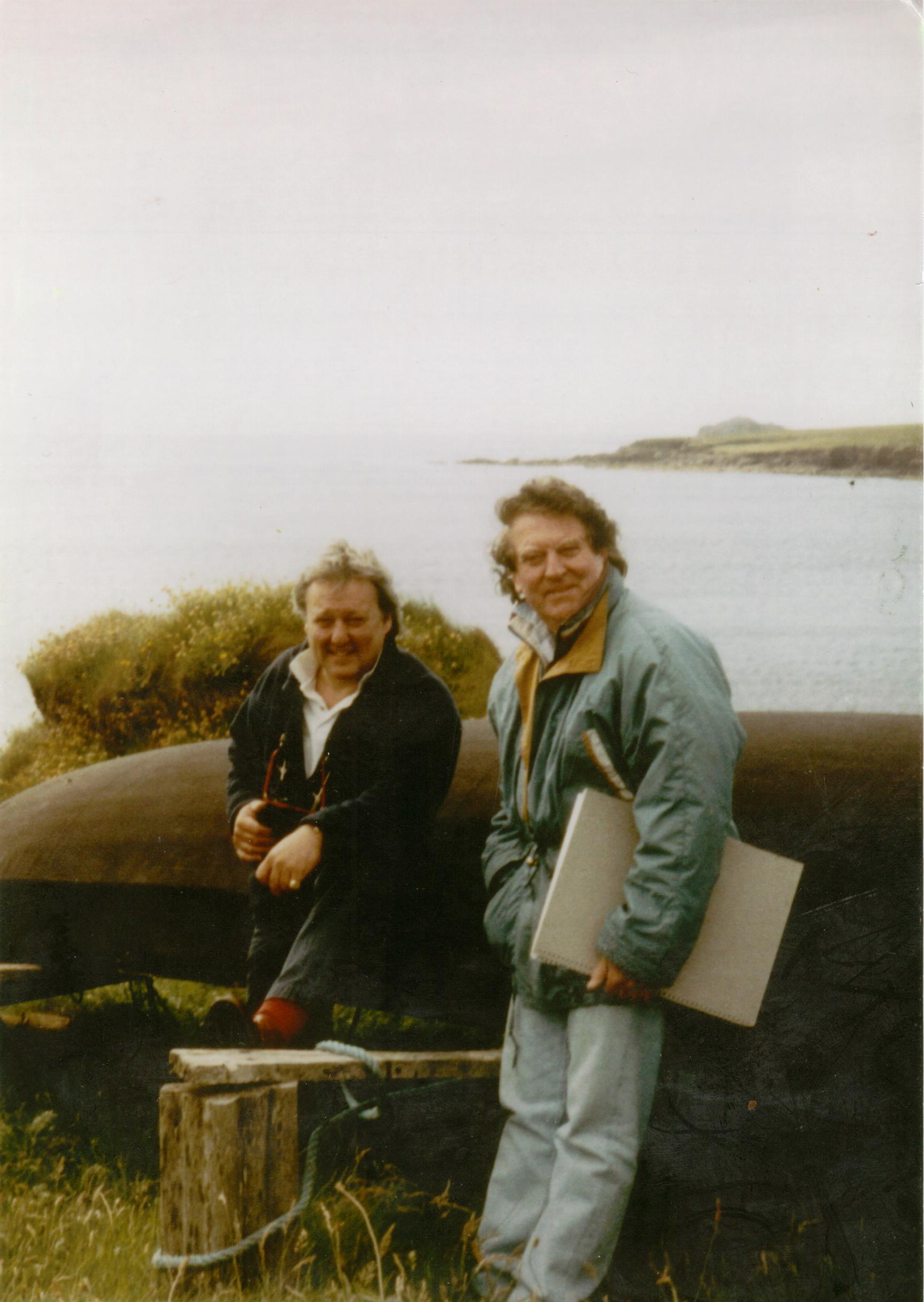- Home » Exhibition » EXHIBITION: Alan Cotton ‘Coast’
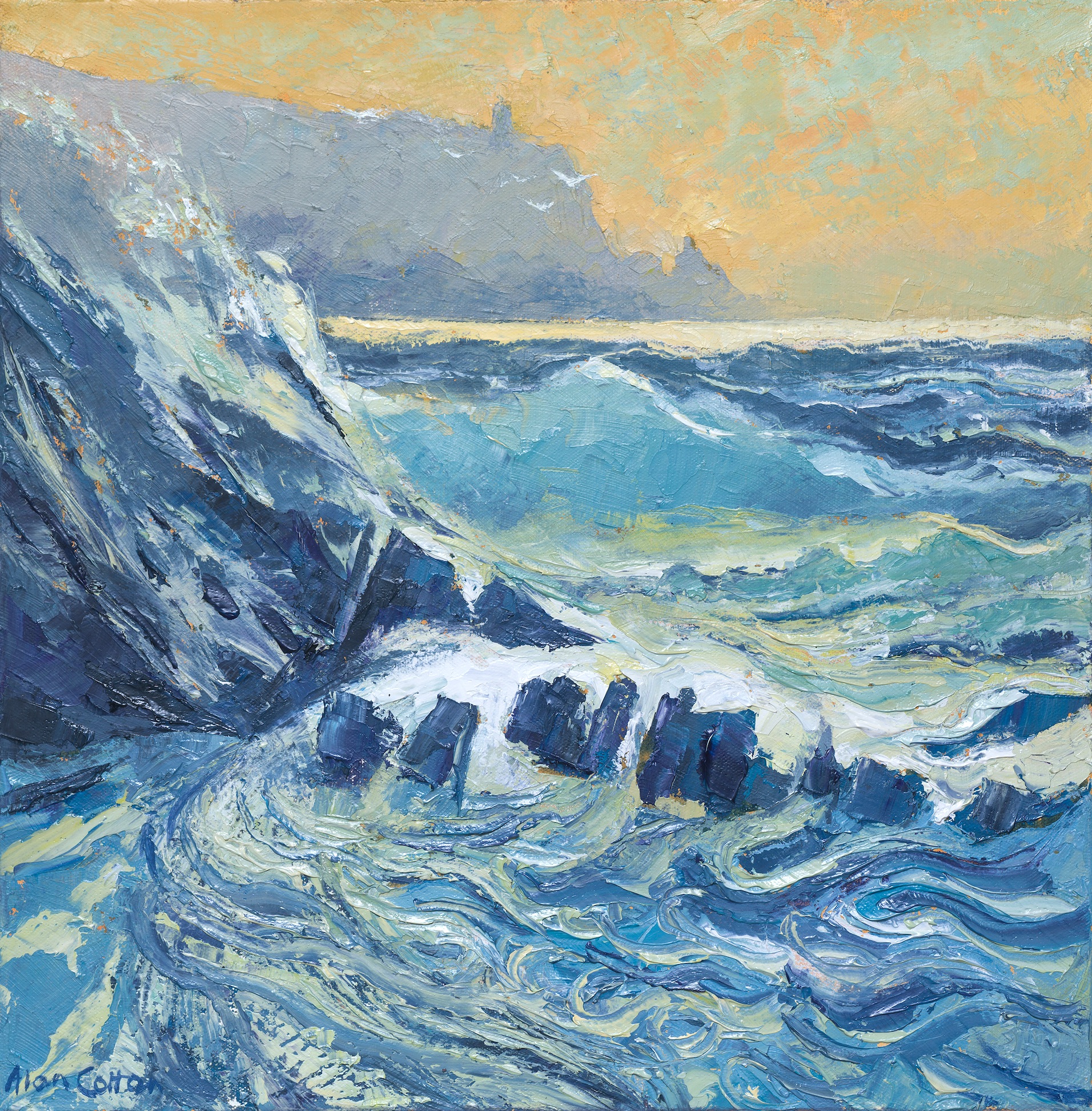
9 April – 9 May
Gallery entry is by annual or single entry membership…read more
Coast is an exhibition of over forty paintings by Alan Cotton, one of Britain’s leading landscape artists, of the coasts of Cornwall, Devon, Somerset, County Kerry, Jersey, the Isle of Skye and New Zealand.
Depicting the the varying moods of the sea as well as the precipitous rock formations and crags that form our coastline, Cotton’s carefully constructed pictures reflect the quiet convolutions of nature and yet its constancy.
There is a strong structure that underpins Cotton’s works; each painting is based on copious sketches giving his pictures vigour and substance but, with his subtle understanding of nature, also a delicacy.
Cotton is a master of painting with the palette knife; a technique which allows for no approximation and the exhibition will reveal the full extent of his remarkable talent in giving almost sculptural form to paint.
The year 2020 will be remembered as one when we all became aware of the British coastline – not only because the Brexit debacle made one conscious of the isolation that the water surrounding our islands provides, but also because of the mass exodus of people from the city travelling to the British seaside in lieu of holidaying abroad.
Not since Edwardian times had the beaches of Devon and Dorset, Cornwall and Somerset been inundated with so many modern-day charabancs, windbreaks and sun hats.
This exhibition features forty works that document the more savage and lonelier parts of the coast; the craggy rocks of North Somerset or County Kerry or the leaden skies of Skye and Jersey.
Alan Cotton does not attempt to paint the ‘pretty’ parts of the coast, preferring instead the fierce and most dra- matic parts of it; the bits that point like daggers into the spray or stretch as muddy estuaries where there is barely a wave to be seen. Unusually for an artist, he often dives beyond the coast into the water; it might seem hard to animate something so formless but Cotton weaves extraordinary texture into what could otherwise be a featureless expanse of water.
Born in Redditch, Worcestershire, Cotton was brought up in a small house which he shared with his parents and four siblings.
‘We all lived in one room with no electricity and my job was to fetch coke from the coke factory for the neighbours’ he recollects. ‘My mother was saintly; she worked incredibly hard – up at 6.30am to work at the milk factory. After finishing that she would go to school to help with the school dinners and then, in the evening would return to the milk factory for the evening shift. She did anything to make some money.’
The countryside saved him, he says, from his cramped domestic circumstances – the vast expanses of cornfields and open skies offered a liberation.
His instinct – which has never left him – was to lose himself through painting. ‘I wasn’t a very good pupil at school because I was always in the art room’ he says. Not being able to afford proper brushes, the earliest he used to be made by his mother from her own hair.
After leaving Redditch grammar school, Cotton went to Bournville and then Birmingham art schools where the distinguished naïf landscapist, Norman Neasom, was his tutor.
‘He taught me to be myself and like me was a local boy made good – he was a great inspiration.’
Since this period Cotton has moved to Devon and expanded his practise beyond just landscape painting.
The paintings in this show depict the varying moods of the sea; what Cotton particularly relishes are the precipitous groynes of rock and crags that form our coastline, embodying the quiet convolutions of nature and its constancy.
There is a strong structure that underpins Cotton’s works; each painting is based on copious sketches giving his pictures vigour and substance but – with his subtle understanding of nature – there is also a delicacy.
Cotton is a master of painting with a knife not a brush; a technique he favours because it allows for a variety of mark-making and celebrates the full sensuality of the paint and its pigment. His thick impasto application of paint means that even reflections on the water’s surface appear as substantial as any object in a scene. Equally, thin traces of paint made with the side of the knife give full definition to pattern and detail.
‘Since the time of the Impressionists, I think it has been recognised that the mark and the quality of the mark is the dynamic of the painting,’ says Cotton. ‘For me the knife allows me to produce so many different marks that I really believe I have a fair bit of control…and the guts of the painting – the whole language of painting – is in the marks. People look at the images and places, but I am as much concerned with the dynamic of the painting – the physical surface, which is very tactile and very sculptural.’
A favourite subject for the artist is the coast at Hartland, the most north westerly point of Devon which is a place that Cotton has returned to again and again to paint the spectacularly folded sequence of shale descending into the sea.
Two beautiful works contrasting the golden light of autumn and the lavender light of winter upon the grassy bluffs are particular highlights of the show.
Others include the snaking sands of the Isle of Skye and the shimmering rock pools of County Kerry that stretch to infinity, the light of the sky creating almost a halo along its edge where it meets the sea.
In addition to his career as an artist, Cotton has been a major force in fostering artistic talent amongst the young. In 2000 he founded the South West Academy for Fine and Applied Art and he was awarded Honorary Doctorates by the Universities of Exeter and Bath for his ‘outstanding contribution to the arts.’
Much of his career has been spent painting abroad – the south of France, Tuscany, Morocco and the Alps – and in 2005 he accompanied HRH Prince Charles, to Sri Lanka, Australia, New Zealand and Fiji as his tour artist.
This show is about his coming home – to places that are familiar but never seen in just one way.
Alan Cotton’s output over more than 30 years has been prodigious. He paints about sixty major works every year and the total number of paintings enjoyed by collectors around the world runs into the thousands.
‘Not for years has so much thought been given to Britain’s coast and borders’ said Johnny Messum, founder of Messums Wiltshire. ‘Alan’s paintings capture the essence of our shoreline, its variety and drama as it has become the focus of attention as contortions of rocky terrain.’
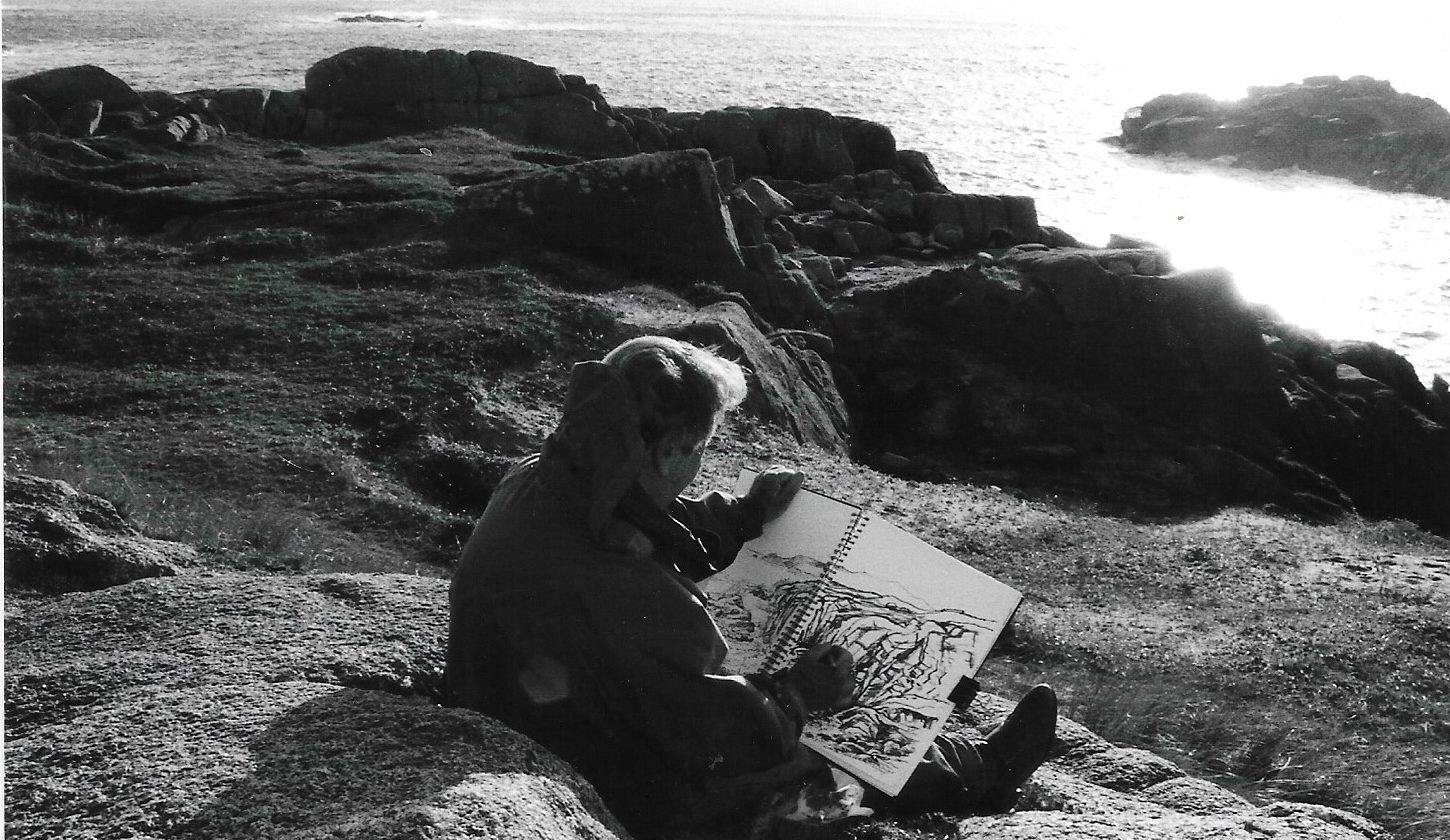
“Drawing is the key to all my work, and I have drawn for as long as I can remember. As a student I would take an easel, canvases, paints and all the paraphernalia, lumbering them across the countryside, to find inspiration for my paintings. Now I travel light, with just a drawing book, pens, a few watercolours and make copious drawings. While I am working, I feel part of the landscape and take in everything, filling my mind and imagination, with a passion to interpret what I see into paintings. From these drawings and notes, and the greatest resource of all, my imagination, I return to my studio to paint.
Some drawings are just quick sketches with notes, but others more elaborate. On the West Coast Ireland, for example, with the ever changing weather from the Atlantic, the light is fleeting, and I need to work quickly to capture what I need for my paintings. In Provence, Piedmonte and Morocco, however, with clear skies and the sun on my back, I sometimes spend several hours drawing from one spot.
What inspires me to want to paint a particular landscape? First of all, of course, it is the location and I have been privileged to find many terrific landscapes in different parts of the world. Even familiar places, however, are transposed by light. I might pass a particular spot many times and have no desire to paint it. Then one day I will see it in a fresh light and the image is magical. Then all my focus is to capture the ephemeral light and pin down the moment. Many of my paintings are done looking into late afternoon or evening light, when you have the greatest tonal contrasts.
I sometimes return to a familiar location, in different seasons and different times of day and it is extraordinary how the familiar changes, as can be seen by the series of Hartland paintings, in this exhibition.
The preparation of my canvases is of paramount importance. We buy huge rolls of heavy cotton duck canvas, because applying heavy impasto paint requires a firm base. We stretch the canvas ourselves, with help from our two sons. We lay the canvases on the studio floor and then begin the preparation, applying two coats of rabbit-skin glue, which seals the weave, and two coats of gesso. I always give them a middle-tone colour wash-colour rather than work on a white surface.
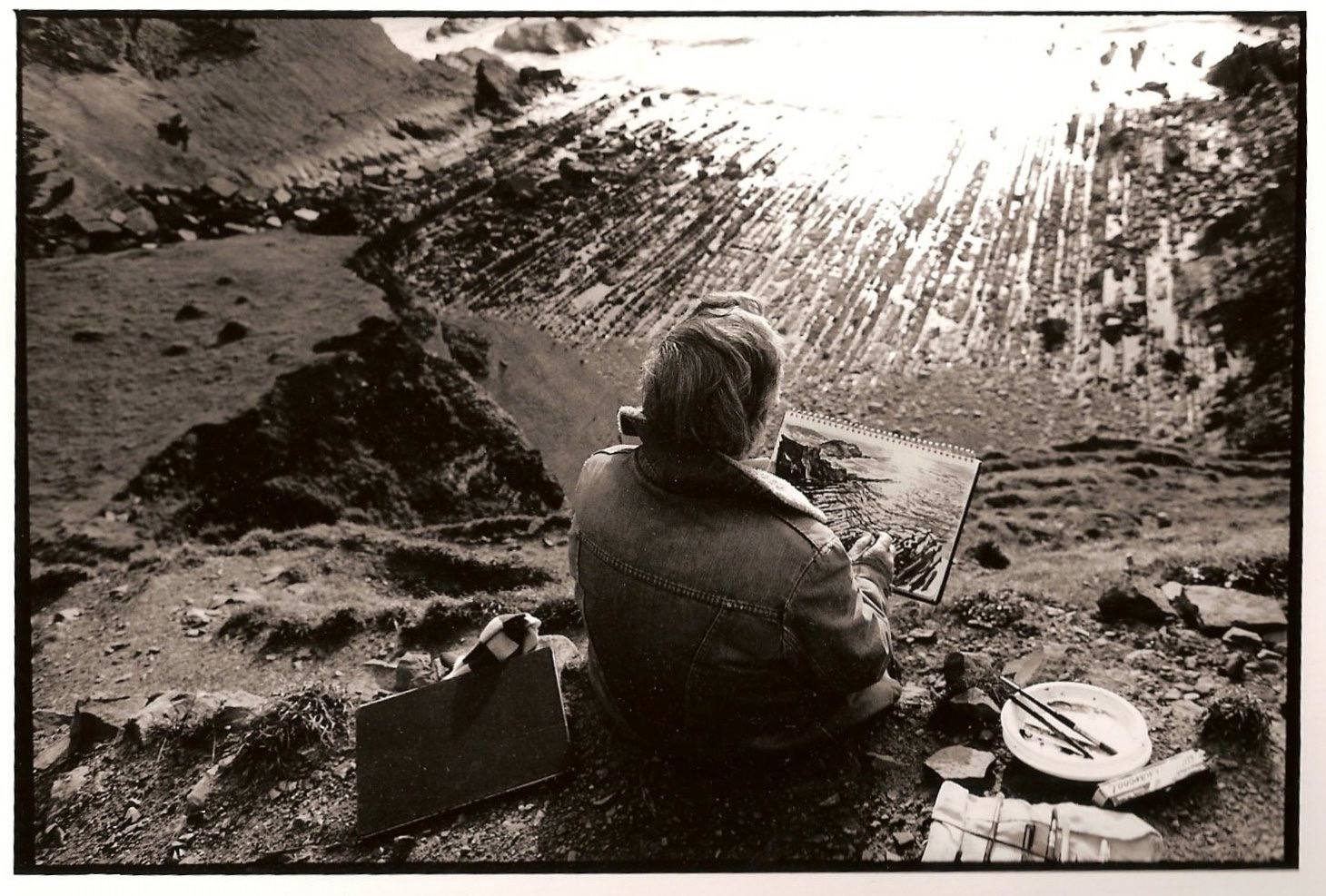
Having selected the size and shape of canvas, to suit a particular idea, I begin to draw the composition, using a brush, to fit all these elements into the shape of the canvas. This is fluid, subject to constant change, until I am finally happy with the drawing.
Then comes the moment when I start to squeeze out paint on
to the palette. Squeezing out large quantities of this sensuous pigment, always excites me. My palettes are large sheets of hardboard, on top of the painting table. As a child and student, I never had enough paint. Now I have rows and rows, of every colour I might need. Sometimes I let the children who visit, squeeze out paint and they start very tentatively. ‘I need more, squeeze harder.’ I say, and see their eyes light up when vermillion or lemon-yellow snake out of the tube. I get that same, child-like pleasure, every time.
Whilst the drawing on the canvas is carefully thought out, applying the pigment, it is purely intuitive, because now I am working only from memory and imagination. Each painting is a journey of discovery. As I apply the pigment, the painting knife becomes part of my hand. I believe my knives are more versatile than a brush. I can can make a hundred different marks with the knife, some of great density, some are tiny textural marks, or I can scrape back to the canvas, to produce a thin glaze. Every mark on my paintings, in this exhibition is made with painting knives and, after many years, I am still discovering new ways to use them.
Alan Cotton
Colaton Raleigh
February 2021
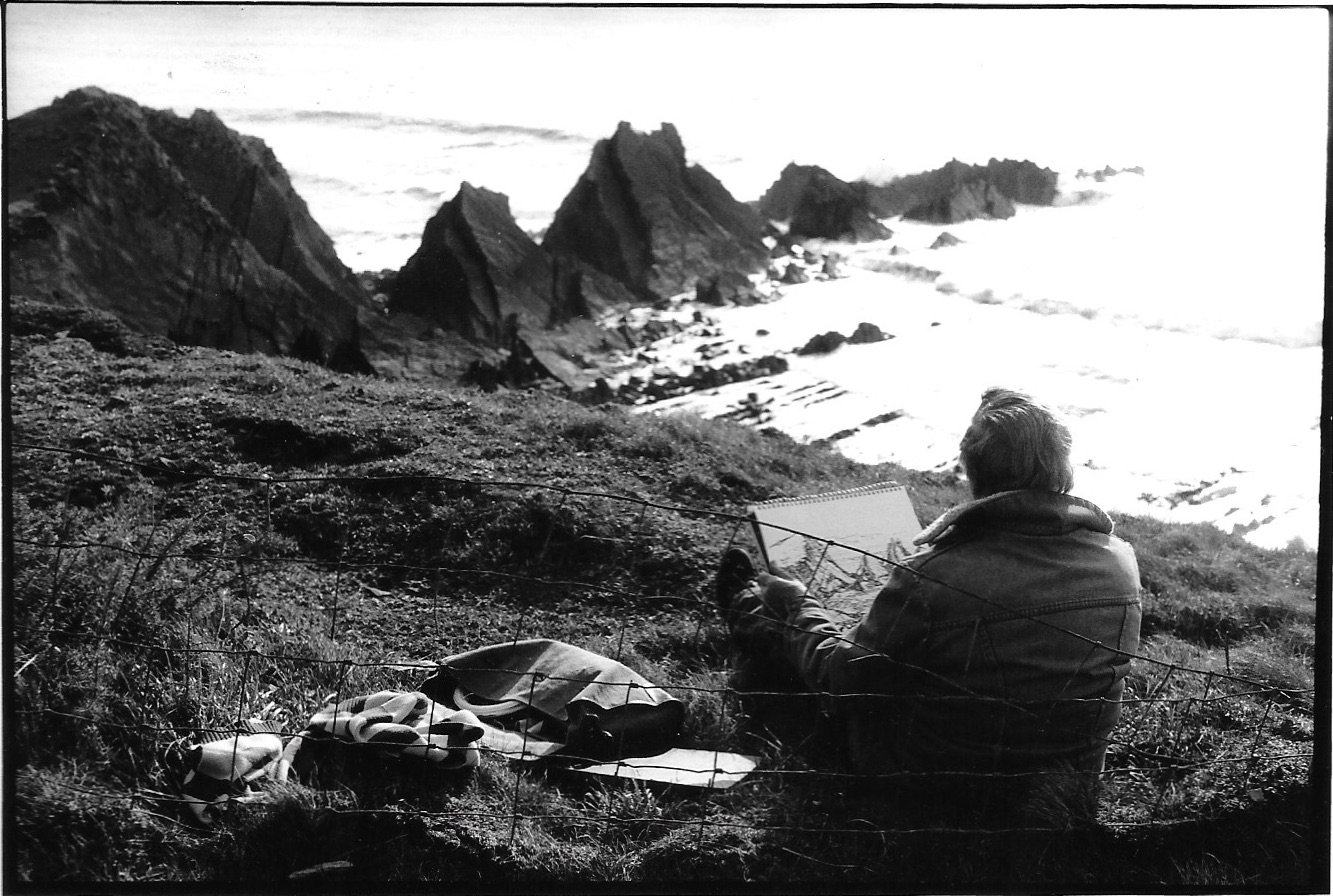
Photography by Paul Gillmore
Our first exhibition together was in 1985 and Alan has been a regular exhibitor with us ever since. As we have a large-ish stable of painters, I am often asked how artists came to us and, indeed, how we find them. Unusually, Alan and I found each other and completely by chance!
When we first met, he was a budding film producer with West Country television and, at the time, working on a film called ‘An Artist on Every Corner’, directed by his long-time friend Kevin Crooks of the BBC. It was to be a new documentary on the rise of public interest in painters of the early Newlyn School. The gallery was championing this interest and had held exhibitions since the 1970s entitled ‘A Breath of Fresh Air’ which featured the main protagonists of the artistic colony that had formed around Newlyn Harbour. There happened to be a very good Thomas Cooper Gotch (1854-1931), a founder member of the school, coming up for auction sale at WH Lane in Penzance, which I was determined to acquire. Alan and his film crew had also discovered the sale. Making myself scarce at the back of the saleroom I was alarmed to find a camera pointing my way as the lot was knocked down to me! The interview afterwards was to be our first meeting and, subsequently, the film finished up at our gallery featuring the forthcoming exhibition. Alan brought up a portfolio of his work to show me and, in-between bouts of filming, we agreed to work together and a year later we had our very first exhibition. It was the Autumn of 1985.
Alan is, of course, infectious – his enthusiasm and conviction towards the Arts are now legendary. We have enjoyed a special relationship with him, his wife Trish and all his family. Alan has invited me on painting trips to share and explore his vision as it progressed from the early work around his home in Colaton Raleigh to trips into Provence, Piedmont, Morocco and latterly the West Coast of Ireland. We shared some great experiences on our trips as we sketched and made notes on the different places we explored. Alan is a great draughtsman and, although it is difficult to believe, behind the heavy impasto paintings there is extensive detailed draughtsmanship exploring his chosen subject. The pictures are created from his home studio, taken from notes that underwrite the colourful marks which make up the surface of his paintings.
Alan is a great colourist, laying on layers of rich colour with his painting knives, a technique he has perfected and has never varied from. I am reminded that one of the first pictures by him which I very much admired on an early visit to his Studio was from the Hartland Cliff Series. They seemed then, like Monet’s studies of Rouen Cathedral, seen at different times and in differing lights.
It is fitting, perhaps, to my long-term relationship with Alan that this exhibition entitled ‘Coast’, which my son Johnathan is staging, should be celebrating his coastal observations as that is where it all began.
